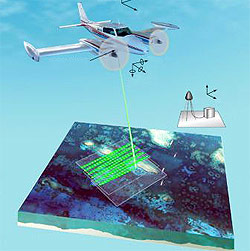 The mission of the Joint Airborne Lidar Bathymetry Technical Center of Expertise (JALBTCX) is to perform operations, research, and development in airborne lidar bathymetry and complementary technologies to support the coastal mapping and charting requirements of the US Army Corps of Engineers (USACE), the US Naval Meteorology and Oceanography Command (NMOC), and the National Oceanic and Atmospheric Administration (NOAA). JALBTCX staff includes engineers, scientists, hydrographers, and technicians from the USACE Mobile District, the Naval Oceanographic Office (NAVOCEANO), the USACE Engineer Research and Development Center (ERDC), and NOAA National Geodetic Survey (NGS).
The mission of the Joint Airborne Lidar Bathymetry Technical Center of Expertise (JALBTCX) is to perform operations, research, and development in airborne lidar bathymetry and complementary technologies to support the coastal mapping and charting requirements of the US Army Corps of Engineers (USACE), the US Naval Meteorology and Oceanography Command (NMOC), and the National Oceanic and Atmospheric Administration (NOAA). JALBTCX staff includes engineers, scientists, hydrographers, and technicians from the USACE Mobile District, the Naval Oceanographic Office (NAVOCEANO), the USACE Engineer Research and Development Center (ERDC), and NOAA National Geodetic Survey (NGS).
JALBTCX executes survey operations using the Compact Hydrographic Airborne Rapid Total Survey (CHARTS) system and industry-based coastal mapping and charting systems. CHARTS, the Mobile District's in-house survey capability, includes an Optech, Inc., SHOALS-3000 lidar instrument integrated with an Itres CASI-1500 hyperspectral imager. CHARTS collects either 20 kHz topographic lidar data or 3 kHz bathymetric lidar data, each concurrent with digital RGB and hyperspectral imagery. Survey operations support the USACE National Coastal Mapping Program and NAVOCEANO nautical charting missions. Survey personnel include contracted employees of Fugro Pelagos, Inc.
JALBTCX research and development support and leverage work in government, industry, and academics to advance airborne lidar and coastal mapping and charting technology and applications. Collaborations currently include the US Geological Survey (USGS), the National Aeronautics and Space Administration's Wallops Flight Facility, US Naval Research Lab, ERDC System-Wide Water Research Program, NOAA NGS), Optech International, the Office of Naval Research, the ERDC Topographic Engineering Center, the University of Southern Mississippi, Ohio State University, the University of Florida, the University of New Hampshire, and Duke University.